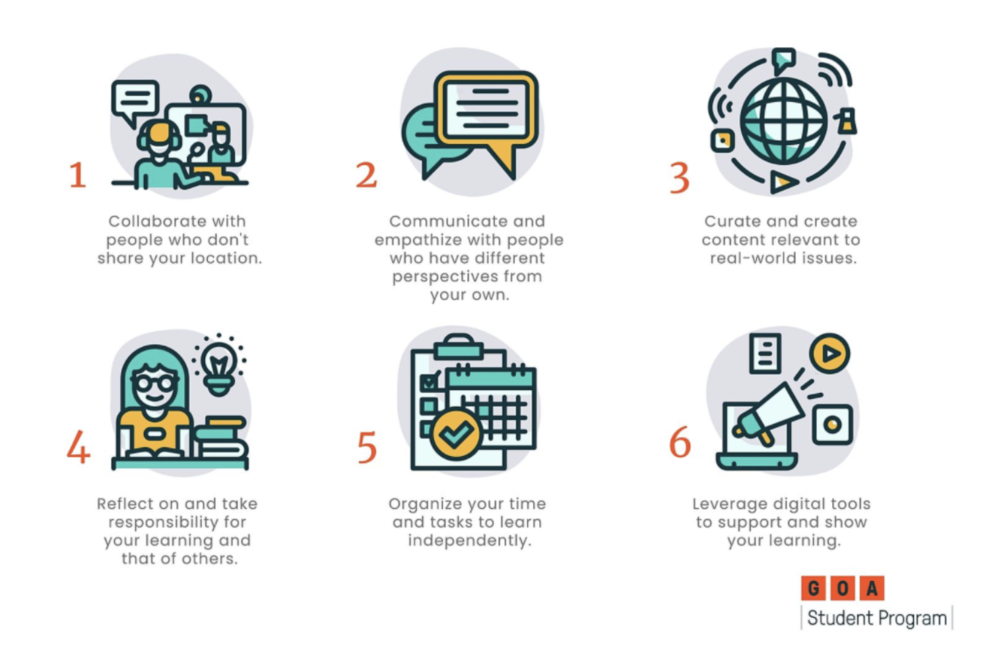Designing a Graduate Profile: Four Essential Steps
How might we redefine success in school to align with the skills and habits of mind students need in college, career, and life?
Graduate Profiles are a way to focus your community on a core set of learning goals, goals that support the development of skills and habits of mind that matter in school and beyond. Especially for schools working to prioritize mastery and personalization, a Graduate Profile helps clarify what we want students to master and why we are committing to personalized pathways that ensure all students reach mastery. The research organization Aurora Institute believes Graduate Profiles are an integral element of adopting competency-based learning. The Mastery Transcript Consortium places them second in its Journeys to Mastery Learning Framework.
Graduate Profiles can take different forms and different names: Portrait of a Graduate, Vision for a Graduate, Learning Goals, Profile of a Learner, etc. In 2016, GOA adopted six core competencies as its vision of a GOA learner.

GOA's Six Core Competencies for Students
No matter which course a student takes, the work they do in that course will develop these skills. Our core competencies are both aspiration and benchmark: they are what our teachers and students aim for in instructional design and coursework, and they are how we assess the quality of GOA learning experiences. To learn more, explore our blog series on competency-based learning.
We see four essential steps to successfully creating and using a Graduate Profile.
1. Understand the Definition and Purpose of a Graduate Profile
A Graduate Profile is a visual representation of the essential skills and habits of mind that define learning experiences at your school. It is an aspirational, memorable, and public commitment to redefine success in terms of those skills and habits of mind rather than accept grades or test scores or accumulated credits as evidence of learning.
Critically, a Graduate Profile is also a commitment to (re)design your school in a way that ensures every student can succeed in fulfilling the profile’s vision for learning. The organization Batelle for Kids, which has led work in the field on this topic, calls it “the north star” that guides decisions about the learning experiences, systems, and structures that define how your school is designed.
Three examples of Graduate Profiles:
2. Align Graduate Profiles to Research and Mission
Graduate Profiles should be research-based and mission-aligned. The elements of a Graduate Profile are most often expressed as domains of learning or competencies that are transferable, transdisciplinary, and relevant to the world beyond school. This reflects what research tells us about learning in a modern world: success in college, career, and life depends on the cognitive and noncognitive skills necessary for lifelong learning.
In order to be memorable, Graduate Profiles are focused. Most of them have somewhere between four and eight elements. Selecting the individual elements for your profile is an opportunity to explore where your school's mission and values intersect with relevant research. As part of this process, schools examine student work from the classroom and beyond; identify and analyze experiences, rituals, and systems that represent them at their best; and consider their school's history and strategic initiatives.
Additional Resources on Core Elements of a Graduate Profile:
- Transcend Education’s “Defining Graduate Aims” Research and Resources
- Center for Curriculum Redesign’s Competencies/Subcompetencies Framework
3. Engage All Stakeholders
Because adopting a Graduate Profile has implications for all elements of a school community, the development of a Graduate Profile should be a community-wide effort. Invite as many stakeholders as possible to engage in the development process. Seeking the input of teachers, students, families, alumni, and other key groups achieves two important goals: 1) it captures diverse perspectives on and perceptions of learning at your school and 2) it involves in the process the people who will be most affected by the Graduate Profile, be it teachers who must adopt elements of the Graduate Profile as learning targets, students who must understand and work towards the profile’s stated goals, or families who must embrace and support its message. GOA's six core competencies are derived from years of surveys and interviews with our students and teachers, data which prioritized those six skills as relevant to success in any course, no matter the content.
Additional Resources on Engaging Stakeholders:
- We’ve seen a variety of approaches to this work, from Punahou School’s design sprints for families to Charles Wright Academy’s mixture of surveys, interviews, and research to Lakeside School’s exploration of environments beyond school to identify competencies and mindsets.
4. Commit to Strategic Implementation
Don’t expend the energy to develop a Graduate Profile if you don’t have a plan for how to use it. For most schools and learning organizations, developing a Graduate Profile is the first step in a multi-year change process to ensure that learning in the classroom and beyond is aligned to the profile’s elements and that systems and structures are in place to ensure that all students receive the support they need to meet those learning targets.
Well-designed Graduate Profiles can be used as rubrics for assessing how well your current school design supports the profile’s vision for learning. They can be used by school leadership for strategic planning, by educators who want to think differently about how learning experiences are designed, and by students as prompts for metacognitive reflection, portfolio design, or proposals for new clubs, projects, or policy changes.
Additional Resources on Aligning School Design to Graduate Profiles:
- The Big Picture Learning Network’s internship/mentorship program is aligned to its five learning goals.
- Mount Vernon School spent five years designing programming aligned to its Mount Vernon Mind Graduate Profile.
The Graduate Profile should become an integral part of the way people perceive, talk about, and experience your school. It can be a bridge between your mission and your program, helping your community and the world beyond your school understand the vision and goals you have for your students.
GOA serves students, teachers, and leaders and is comprised of member schools from around the world, including independent, international, charter, and public schools. Learn more about Becoming a Member. Our professional learning opportunities are open to any educator or school team. Follow us on LinkedIn and Twitter. To stay up to date on GOA learning opportunities, sign up for our newsletter.



